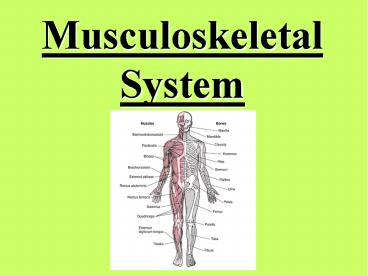Musculoskeletal System - PowerPoint PPT Presentation
Title:
Musculoskeletal System
Description:
Musculoskeletal System Musculoskeletal system refers to the muscles and skeleton of the human body. Our muscles and skeleton work together to protect organs, enable ... – PowerPoint PPT presentation
Number of Views:639
Avg rating:3.0/5.0
Title: Musculoskeletal System
1
Musculoskeletal System
2
Musculoskeletal system refers to the muscles and
skeleton of the human body.
Our muscles and skeleton work together to protect
organs, enable movement and give the body its
general shape.
3
The Skeletal System
4
The Skeletal System
- The skeleton is a group of bones and cartilage
which provide a framework for the muscle
attachment. - The skeleton helps protect the bodys vital
organs. - For example - the rib cage
protects the lungs and heart. - the skull
protects the brain.
- Bone marrow produces our blood cells
- (illustration on the following page)
5
A Look at Bone Marrow
6
Joints
- A joint (join - t) is the area where two bones
connect. - A joint enables us to bend, twist and rotate.
- Most joints are moveable.
7
- Four Types of Moveable Joints
Name Function Example
Ball-and-Socket Joints Enable bones to move in all directions. hips shoulders
Hinge Joints Enable bones to move in two directions. knees elbows
Pivot/Rotating Joints Enable side to side rotation. neck
Gliding Joints Enable flat bones to glide over each other hands spine
8
Four Types of Moveable Joints
9
The Muscular System
10
- Muscular System
- Muscles attach to the skeleton whereby
- holding the skeleton together
- giving the body its general shape
- enabling movement
- Muscle contractions help to control body
processes such as breathing, digestion and blood
flow. - Skeletal muscles are voluntary muscles.
11
- Voluntary and Involuntary Muscles
- 1. Voluntary Muscle contractions are controlled.
- Example skeletal muscles (biceps and
triceps) - 2. Involuntary Muscle contractions occur
automatically. - Example cardiac (heart) muscles































